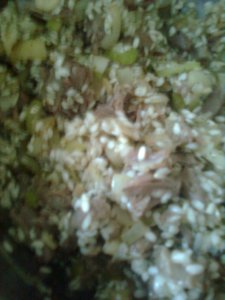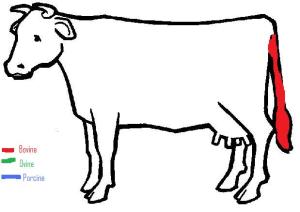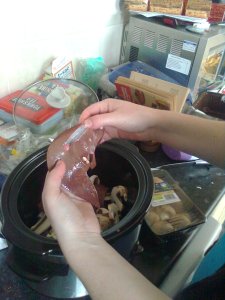The first thing to understand is that a stew is Nigeria is what we would call a sauce. Understand? Good.
In working my way along the animal, after the tail, the toes seemed like the next appropriate spot to move to. There’s recently been some good trotter chat on twitter, so if you want to keep abreast of that, you’d better give me a follow! Acting on the advice of Luke from the restaurant Dough, then disregarding it somewhat (sorry), I slow cooked my trotters in water with four cloves for six hours on high. This makes the most amazing stock. However, I made a beginnners mistake and realised after I’d removed the elbows that what I had were not chunky back trotters, but slimline fore trotters – that equals less meat.
Another thing to note. Always buy your trotters from the back end of the pig. Not the front. No joke.
Then I had a massive bowl of stock with lots of bones and bits of pig in it. I went through the bowl, removing the bones and breaking the skin up and removing any bits of cartilage that I didn’t think would be good to eat. I then had a smaller bowl of meat (included skin and tendons and all the bits, because of the slow cooking they are ALL GREAT TON EAT) and a bigger bowl of stock.
Now, time to make my sauce. I got the recipe from my first foodie penpal Jen who runs the Sharing Supper Club. I read it and then did it slightly differently. I must learn to concentrate whilst cooking.
So for a Nigerian stew – which means what? You need:
1 onion chopped, 1 can chopped tomatoes, quarter teaspoon cameroon pepper, half a can of stock, fresh thyme
I cooked the onion tomatoes and spice together for about fifteen minutes, then blended them to smooth and returned to the pan and added some of the bowl of pork trotter stock.
Then I had Nigerian stew. The thyme goes on top as you serve it.
It is very easy. I got the spice from Jen, but if you live in Leeds you could get it from one of the African shops in the market. I almost bought some dried smoked shrimps today – any ideas for them?
I then added my bowl of trotter meat and stirred it all together.
It goes to a really lip-smakcing sauce. We had a few spoons of it with some rice (cooked in the rest of the pork stock) and a couple of tortillas.
Lip-smacking is the word. Even Daz’s friend Bill who shuddered when Daz showed him a picture of the trotter in our fridge, liked it.
Testicles tomorrow! I’d better not balls them up! ho ho *crawls into a corner*





















